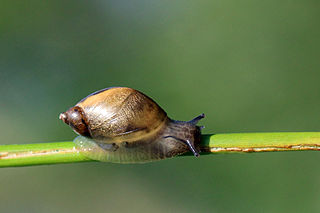
Succineidae are a family of small to medium-sized, air-breathing land snails, terrestrial pulmonate gastropod molluscs in the superfamily Succineoidea.
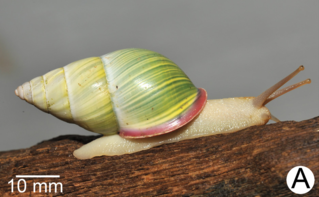
Amphidromus is a genus of tropical air-breathing land snails, terrestrial pulmonate gastropod mollusks in the family Camaenidae. The shells of Amphidromus are relatively large, from 25 mm (0.98 in) to 75 mm (3.0 in) in maximum dimension, and particularly colorful. During the 18th century, they were among the first Indonesian land snail shells brought to Europe by travelers and explorers. Since then, the genus has been extensively studied: several comprehensive monographs and catalogs were authored by naturalists and zoologists during the time period from the early 19th to the mid 20th centuries. Modern studies have focused on better understanding the evolutionary relationships within the group, as well as solving taxonomic problems.

Cernuella virgata, also known as Helicella virgata, common name, the "vineyard snail", is a species of small, air-breathing land snail, a pulmonate gastropod mollusc in the family Geomitridae, the hairy snails and their allies.

Cochlicella acuta, common name the pointed snail, is a species of small but very high-spired, air-breathing land snail, a pulmonate gastropod mollusk in the family Geomitridae.

Helicella itala is a species of medium-sized, air-breathing land snail, a terrestrial pulmonate gastropod mollusk in the family Geomitridae, the hairy snails and their allies.

Macrochlamys indica or the horntail snail is a species of air-breathing land snail, a terrestrial pulmonate gastropod mollusk, in the family Ariophantidae.

Succinella oblonga is a species of air-breathing land snail, a terrestrial pulmonate gastropod mollusk in the family Succineidae.
Catinella is a genus of small air-breathing land snails, terrestrial pulmonate gastropod mollusks in the family Succineidae, the amber snails.
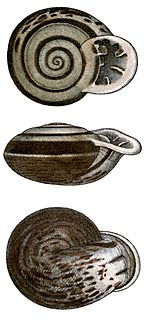
Anostoma, common name the up-mouth snails, is a genus of tropical air-breathing land snails, terrestrial pulmonate gastropod mollusks in the family Odontostomidae. Snails in this genus are found in Brazil.

Ringicella is a genus of tropical air-breathing land snails, terrestrial pulmonate gastropod mollusks in the family Odontostomidae.

Anostoma depressum is a species of air-breathing land snail, a terrestrial pulmonate gastropod mollusc in the family Odontostomidae.

Holospira is a genus of air-breathing land snails, terrestrial pulmonate gastropod molluscs in the family Urocoptidae.

The reproductive system of gastropods varies greatly from one group to another within this very large and diverse taxonomic class of animals. Their reproductive strategies also vary greatly, see Mating of gastropods.
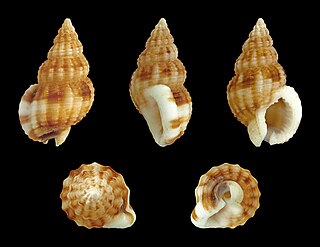
Tritia incrassata, common name the thick-lipped dogwhelk, is a species of small sea snail, a marine gastropod mollusk in the family Nassariidae, the Nassa mud snails or dog whelks.
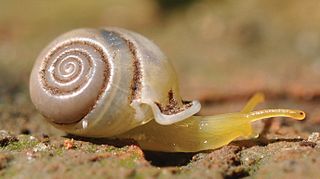
Perrottetia is a genus of air-breathing land snails, terrestrial pulmonate gastropod mollusks in the family Streptaxidae.

Corona pfeifferi is a species of air-breathing land snail, a terrestrial pulmonate gastropod mollusk in the family Orthalicidae.
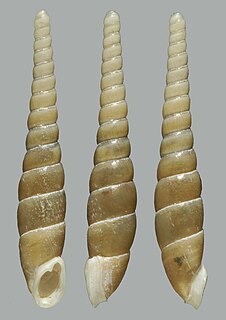
Leptacme cuongi is a species of air-breathing land snail, a terrestrial gastropod mollusk in the family Clausiliidae, the door snails.

Atractophaedusa smithi is a species of air-breathing land snail, a terrestrial gastropod mollusk in the family Clausiliidae, the door snails.

Marstonia comalensis is a species of minute freshwater snail with a gill and an operculum, an aquatic gastropod mollusk or micromollusk in the family Hydrobiidae. It is found in south central Texas, United States.

Galba meridensis is a species of air-breathing freshwater snail, an aquatic pulmonate gastropod mollusc in the family Lymnaeidae, the pond snails.





















